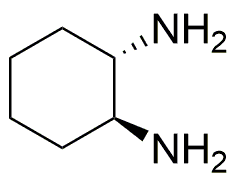(1S,2S)-(+)-1,2-Cyclohexanediamine is widely utilized in research focused on
- Pharmaceutical Development: This compound serves as a chiral building block in the synthesis of various pharmaceutical agents, enhancing the efficacy and selectivity of drug formulations.
- Catalysis: It is employed as a ligand in asymmetric catalysis, facilitating reactions that produce enantiomerically pure compounds, which are crucial in the production of fine chemicals and agrochemicals.
- Polymer Chemistry: The compound is used in the formulation of polyurethanes and other polymers, improving their mechanical properties and thermal stability, making them suitable for a range of industrial applications.
- Analytical Chemistry: It acts as a reagent in various analytical techniques, aiding in the detection and quantification of metal ions in environmental samples, which is vital for pollution monitoring.
- Material Science: This chemical is utilized in the development of advanced materials, such as coatings and adhesives, that require specific bonding characteristics and durability, catering to industries like automotive and construction.
General Information
Properties
Safety and Regulations
Applications
(1S,2S)-(+)-1,2-Cyclohexanediamine is widely utilized in research focused on
- Pharmaceutical Development: This compound serves as a chiral building block in the synthesis of various pharmaceutical agents, enhancing the efficacy and selectivity of drug formulations.
- Catalysis: It is employed as a ligand in asymmetric catalysis, facilitating reactions that produce enantiomerically pure compounds, which are crucial in the production of fine chemicals and agrochemicals.
- Polymer Chemistry: The compound is used in the formulation of polyurethanes and other polymers, improving their mechanical properties and thermal stability, making them suitable for a range of industrial applications.
- Analytical Chemistry: It acts as a reagent in various analytical techniques, aiding in the detection and quantification of metal ions in environmental samples, which is vital for pollution monitoring.
- Material Science: This chemical is utilized in the development of advanced materials, such as coatings and adhesives, that require specific bonding characteristics and durability, catering to industries like automotive and construction.
Documents
Safety Data Sheets (SDS)
The SDS provides comprehensive safety information on handling, storage, and disposal of the product.
Product Specification (PS)
The PS provides a comprehensive breakdown of the product’s properties, including chemical composition, physical state, purity, and storage requirements. It also details acceptable quality ranges and the product's intended applications.
Certificates of Analysis (COA)
Search for Certificates of Analysis (COA) by entering the products Lot Number. Lot and Batch Numbers can be found on a product’s label following the words ‘Lot’ or ‘Batch’.
*Catalog Number
*Lot Number
Certificates Of Origin (COO)
This COO confirms the country where the product was manufactured, and also details the materials and components used in it and whether it is derived from natural, synthetic, or other specific sources. This certificate may be required for customs, trade, and regulatory compliance.
*Catalog Number
*Lot Number
Safety Data Sheets (SDS)
The SDS provides comprehensive safety information on handling, storage, and disposal of the product.
DownloadProduct Specification (PS)
The PS provides a comprehensive breakdown of the product’s properties, including chemical composition, physical state, purity, and storage requirements. It also details acceptable quality ranges and the product's intended applications.
DownloadCertificates of Analysis (COA)
Search for Certificates of Analysis (COA) by entering the products Lot Number. Lot and Batch Numbers can be found on a product’s label following the words ‘Lot’ or ‘Batch’.
*Catalog Number
*Lot Number
Certificates Of Origin (COO)
This COO confirms the country where the product was manufactured, and also details the materials and components used in it and whether it is derived from natural, synthetic, or other specific sources. This certificate may be required for customs, trade, and regulatory compliance.


